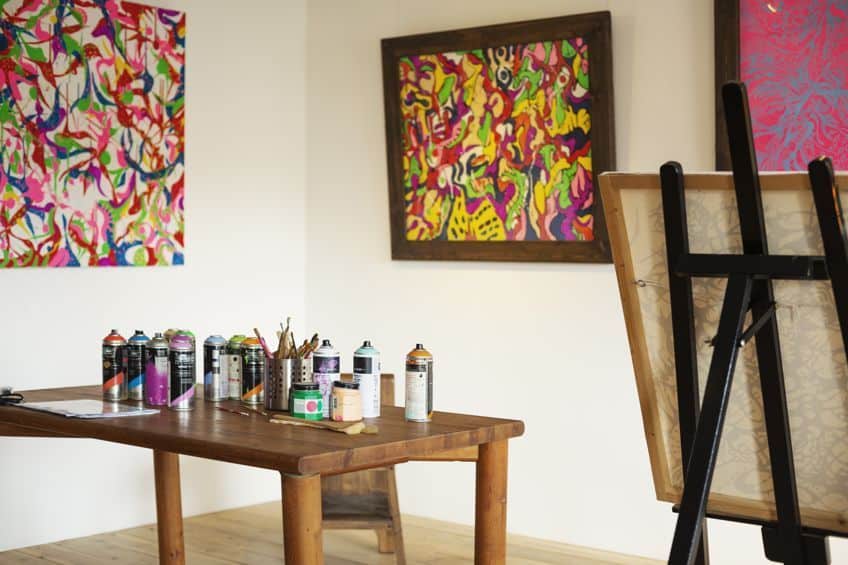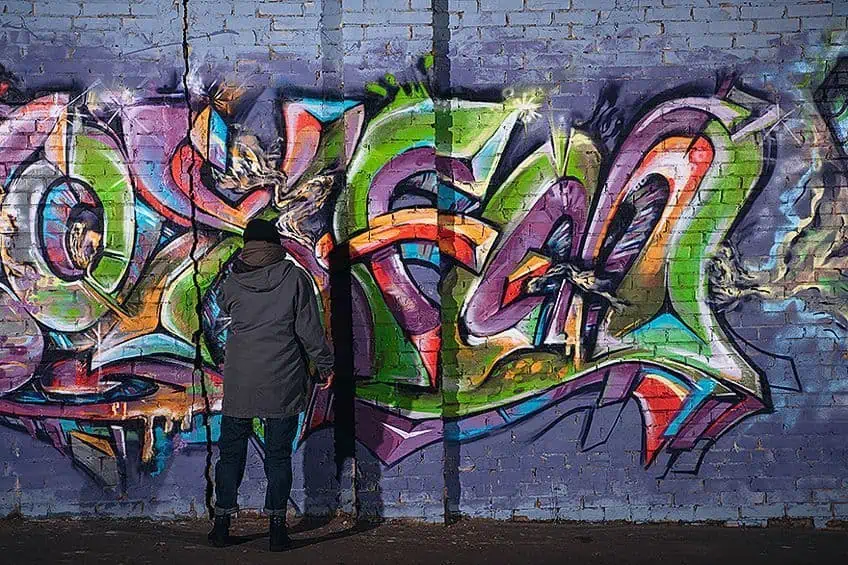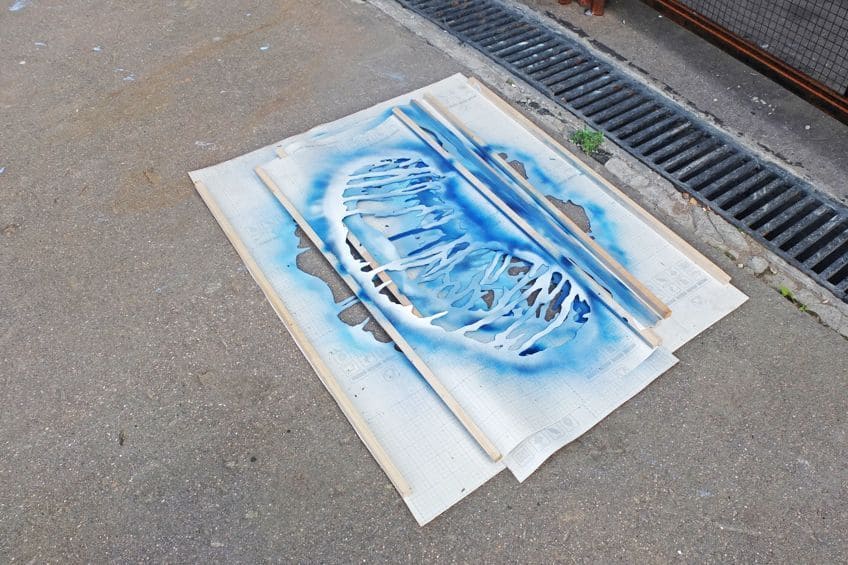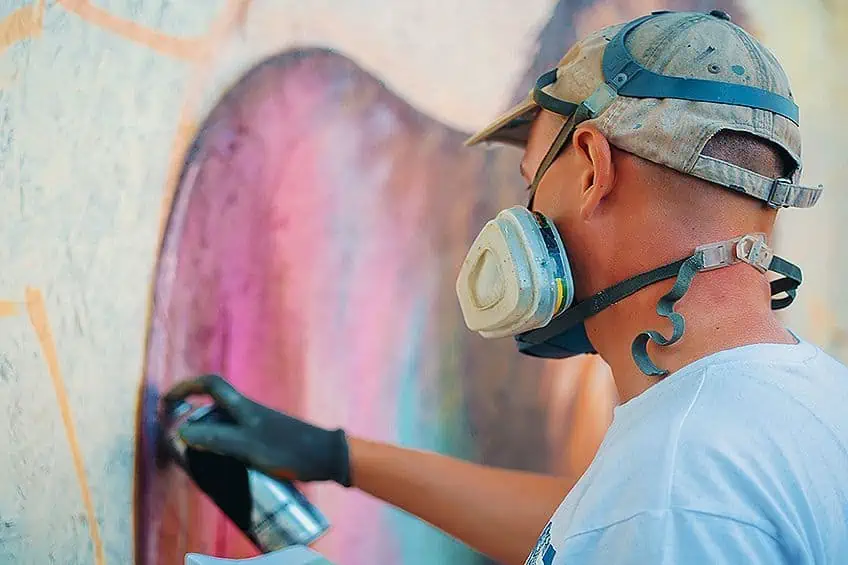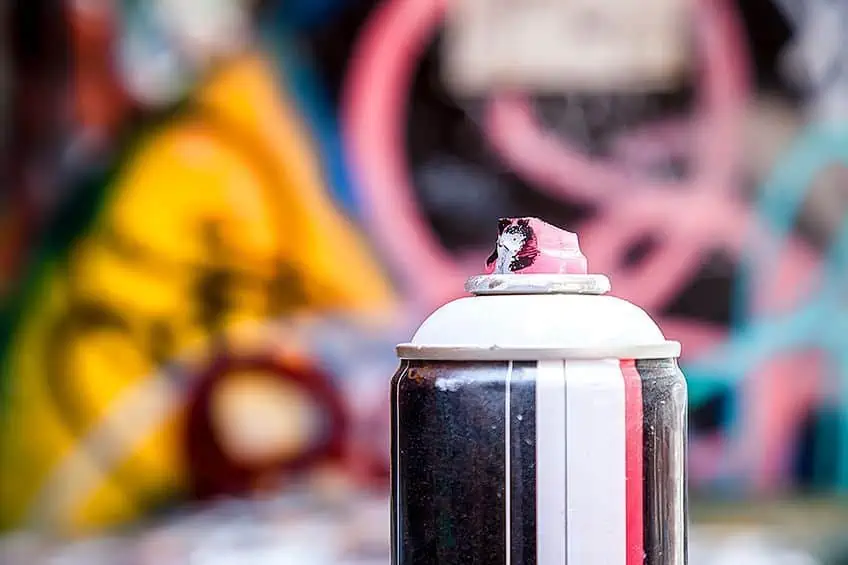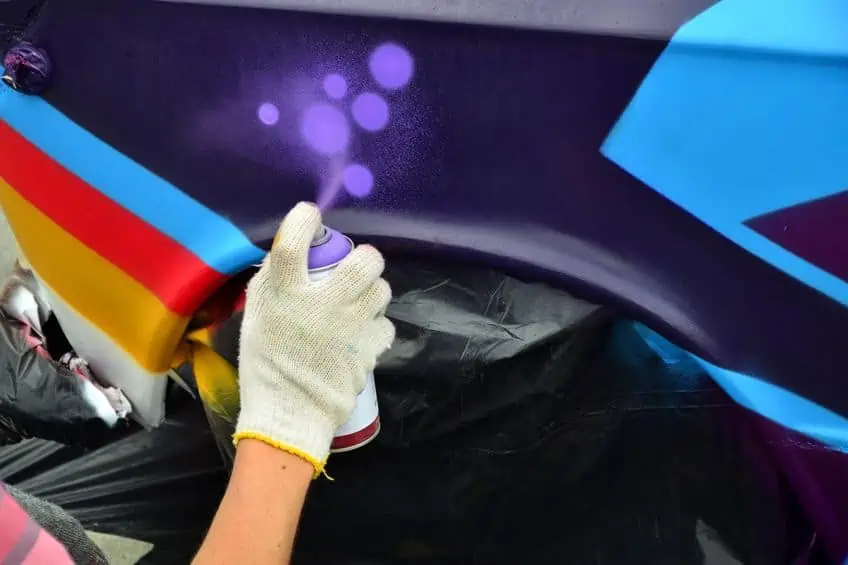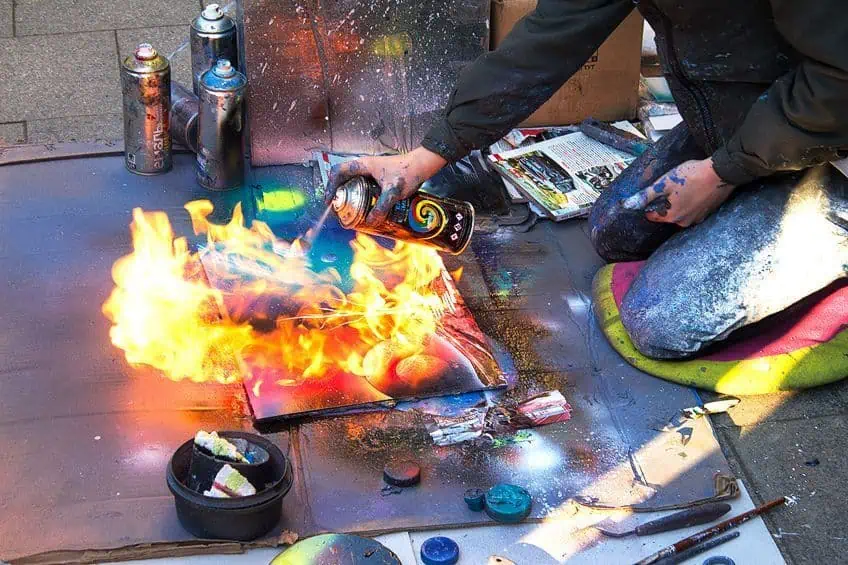Spray Paint Art – A Guide to Using Spray Paint Professionally
You may be familiar with the many traditional mediums and techniques used to create paintings; however, spray painting may be one medium that has evaded your line of exploration. Commonly associated with street art and graffiti, spray paint art can be used in a variety of contexts for different purposes. In artistic production, it can be used to create a wide range of effects on a much larger scale and is a great art form for any artist to explore! In this article, we will introduce you to a history of spray-painting art, including a spray paint tutorial, and all the valuable tips and tricks you need to know on how to create spray paint artwork! Keep reading for more about this dynamic and versatile art form!
Spray Painting for Beginners: What Is Spray Paint?
What is spray paint art? When did it originate? And have you ever wanted to learn how to do spray paint art? Spray paint is one of the most common mediums of the 21st century and is most often found in street art. The art of spray painting involves applying paint using an aerosol can to non-porous materials such as glass, ceramic, plastic, wood, and other materials. While many people carry misconceptions about the role of spray paint in urban landscapes and street art, spray painting is one of the most dynamic and multifaceted art forms to date. Whether it is a monochrome painting or a multicolored painting, spray paint artworks are incredibly diverse and can be adapted to the material on which they are laid. Spray paint art is also an interesting art form for artists to explore gradation and large-scale compositions to bring an added sense of life to their work while tapping into the realm of public art.
A History of Spray Paint Art
Before we dive into the how and what is involved in spray paint art, it is always important to understand the medium and its history in the context of its origin and potential resting place. In the genre of street art, spray paint art is also identified as graffiti art or aerosol art and is credited to the 1970s New York urban underground scene where it first originated as a subculture. Spray paint art could be found in various public spaces and neighborhoods across New York, including subway trains and abandoned buildings where artists would tag their names in various calligraphy styles. Over time, tagging became street art, and soon spray paint art evolved to become one of the most popular street art forms of the 21st century.
The history of spray paint in performance art was also traced back to Mexico City in the early 1980s when an artist named Ruben Fernandez took to the streets of La Zona Rosa and experimented with spray paint art.
By 1982, Fernandez, who was best known as Sadot, had garnered a great deal of public attention through his public street art performances, which involved the artist sitting in a lotus position on the street surrounded by his spray paint cans. The performative manner of his work attracted many crowds to witness his spray-painting abilities as he created many natural landscapes and portraits on different materials without using a paintbrush. Another important aspect of his spray-paint artwork was the music that accompanied his performances.
It is believed that his music formed an integral part of the experience of his spray-painting performance since it attracted a large audience and captivated viewers as they followed the performance. His selection of music during performances included rock, traditional Hispanic sounds, and classical music. In addition to his performance, Sadot also shocked viewers by including comments and opinions on political and governmental issues as well as personal metaphysical observations on society and the human condition. What attracted people to Sadot was not only how he performed spray painting but also the rapid pace at which he produced ready-made paintings and artworks using aerosol cans. Sadot was one of the first street artists of the 1980s to pioneer the art of aerosolgrafia and how he performed it highlighted an aspect of street art that the fine art sphere was not entirely ready to accept just yet.
Other speculations on who the first spray paint artists are include science fiction illustrator Frank Frazetta who thrived in the 20th century and created many striking and iconic illustrations for popular fantasy literature, including Tarzan and Conan the Barbarian. While Frazetta was not a spray paint artist in the public eye, he was a prominent painter of the 20th century whose vivid imagery and bold use of color and form on fantastical figures and landscapes have inspired many street artists.
How to Spray Paint Art: A Complete Guide for Beginners
If you have never picked up an aerosol can create spray paint art, do not worry! Below, we will outline some of the essential spray-painting art supplies that will help you learn how to spray paint art and start your venture into street art. Spray paint can be a great way to get the job done quicker, however, remember that every art form takes practice so do not freak out if your artwork turns out slightly different from that of your vision! Below, we will explore a list of the most important supplies needed when spray painting, as well as the top three spray paints on the market that will help you narrow down your search for the right spray paint.
Later, we will also look at a step-by-step tutorial on spray painting for beginners, which will help you learn how to spray paint art, including different techniques that you can try when experimenting!
Essential Spray-Painting Supplies
Before you start working on your spray-painted masterpiece, be sure to check that you have covered all the items on this list of essential spray-painting supplies. Below, we have compiled a list of items that will be useful for beginners to experiment with and test the limits of their spray-painting abilities. Starting small is always better, and if you feel comfortable, you can always switch to larger materials.
- Spray Paint: You cannot get the job started if you do not have the bare essentials – spray paint or aerosol-based paint. When selecting spray paint, it is important to do your research on the brand you are looking at as well as the surfaces for which the paint was made. There are numerous brands to pick and choose from and just because it is an aerosol can, does not mean that it is the right spray paint for your project.
- Respirator: This is first and foremost the most important supply when working with aerosol paints. Using a respirator is essential to ensure you protect your respiratory system from any toxic fumes and prevent further illness. By using a respirator, you can also paint for a longer duration if you do not like to be interrupted in your production process.
- Paint Thinners: Paint thinners are essential for removing any unwanted splatters of paint, especially since it is almost guaranteed to happen in the field of spray paint art. Another precaution that you can use to add a little more accuracy and neatness to your project is to have a roll (or two) of masking tape on hand.
- Newspapers or plastic drop sheets: Including newspapers or plastic drop sheets are essential if you wish to protect the floor or space on which you are working. You can place your canvas on a drop sheet or create a protective backdrop on a wall with your canvas mounted for added “room-for-play” when creating.
- Spray paint artwork surface: A surface is essential for your artwork since it is the foundation of your work. You may use any textured or flat surface as the foundation of your artwork. This can be a canvas, a piece of paper, or a wall if you are lucky!
- Stencils: Stencils can be incredibly fun and useful in spray paint art. These can be cut-outs of different shapes or patterns that will be used to block out areas of the surface to create a negative image of that shape or pattern. After spray painting over the stencil, the area masked by the stencil will appear “untouched” after you have removed it. Similarly, you can also play with masking tape for linear features. Painter’s tape can also be used to create sharp lines on your artwork.
Top-Rated Spray Paints for Spray Paint Art
As mentioned above, selecting the correct spray paint is essential to ensuring your project is a success. Below, we have compiled a short list of the top three spray paints that have been rated as the best of the best. We have also included the pros and cons of each product so that you can make an informed decision that best fits your project!
Montana Black
Montana Black was rated among the best spray paints used in the professional industry that is also considered to be one of the finest quality spray paints on the market. If you are looking to invest in professional high-quality spray paint, then Montana Black should be your top choice. Below, we have listed the pros and cons of the Montana Black line to help you arrive at your shopping decision faster!
- High-covering matte finish that is weather-proof
- Montana Black offers a range of colors to choose from
- The Montana Black range includes a high-pressure valve
PROS
- The Montana Black range is ideal for experienced graffiti artists since the high quality finish is also equipped with a nitro-combi lacquer base.
- The Montana Black range includes a high-pressure valve, which will help you paint a wider surface area in a quicker and more efficient way.
- Matte finish: If you are looking for flatter and less glossier colors, Montana Black’s low gloss sheen finish provides a more professional aesthetic that is guaranteed to make your work stand out.
- Montana Black is weatherproof, which makes it perfect for outdoor projects that are prone to significant weathering. Your artwork will not only last longer but also retain its color quality.
- Quick drying time: A quick drying time is perfect for anyone looking to optimize on time while completing a project within a tight deadline.
- Montana Black offers a range of colors to choose from: With around 136 colors to choose from, you cannot go wrong.
- You can use Montana Black on a wide variety of materials, including metal, plastic, glass, and wood.
CONS
- The higher price point is considered a con, however, if you have the budget, you cannot go wrong with the quality of Montana Black.
- The highly rated spray paint was also praised for its ease of use, however, some reviews indicate that a few people had issues with the spray paint cap and figuring out how to use the spray paint. Despite these minor issues, Montana Black is among the best spray paints on the market.
Montana MTN 94
Closely following Montana Black is the MTN 94 range, which is the more affordable route that also provides a similar matte finish.
- Best covering low-pressure spray paint available
- Features an easy-to-use low-pressure valve
- The Montana MTN 94 has been rated as easy to use
PROS
- Low-pressure spray paint: The Montana MTN 94 differs from the Black line in that it is a low-pressure spray paint, which means that you can narrow in on those finer details.
- Montana MTN 94 offers a modified synthetic resin pigment, which allows for a much more vibrant color palette.
- The Montana MTN 94 has been rated as easy to use and is perfect for those looking for vibrancy and ease of use.
- Montana MTN 94 also boasts a quick drying time and a product that will not break the bank.
CONS
- The Montana MTN 94 is susceptible to overspray so make sure that you have additional measures to ensure neatness and clean edges in your work.
- The Montana MTN 94 spray paint was also criticized for its cap clogging issues, however, the majority of reviews praise the line for its pigmentation quality and ease of use.
Plutonium
Plutonium has been reviewed as one of the most versatile spray paints available for professional artists. It is advised that beginners stick to other spray paints such as Krylon when experimenting to avoid unnecessary costs and disappointments when attempting to use a higher quality spray paint.
- Ideal for use on a wide range of surfaces from metals to wood
- Provides a smooth satin-like finish that is fast-drying
- Features an ergonomic seamless can and unique valve system
PROS
- Plutonium can be used on a variety of surfaces and is perfect for experimental artists looking for a versatile spray paint that settles easily on all kinds of surfaces.
- Plutonium boasts a highly durable paint quality that has been praised by artists who have pointed out that it has resisted cracking, chipping, and peeling while leaving you with a long-lasting clear finish.
- Plutonium can also be used on fabrics despite it initially being developed for use on cars.
- Plutonium offers a satin finish and is drip-free, which is a win for all artists looking to explore different aesthetic qualities without the messy factor.
- Plutonium comes with a dual valve system that enables one to spray paint upside down.
- Plutonium can be used to paint on wet surfaces, thus allowing for more visual experimentation and is safe for use in both indoor and outdoor environments.
CONS
- There have been a few minor complaints about the spray paint’s durability, however, the majority of people who have tested the product praise its versatility and ease of use across mural art, home decor, and car paint uses.
A Step-by-Step Spray Paint Tutorial: How to Create Spray Paint Art
Now that you’ve gotten the idea of the art supplies required to begin making your spray paint art you can now enjoy this step-by-step spray paint tutorial on how to do spray paint art for beginners. Before you begin creating it is useful to look at a few spray paint artists of the Contemporary era who may inspire you. A few famous street spray painting artists include figures such as Sainer, Stinkfish, David Walker, PichAvo, and Eelco van den Berg among many other talented street artists.
Step 1: Select a Surface
The first step to creating your spray paint artwork is to select the surface that you want to paint on. This can range from a variety of materials, including wood, cardboard, glass, canvas, fabric, or even an unused wall in your backyard.
By selecting a surface, you narrow down the search for the correct spray paint, which is part of the next step.
Step 2: Choose a Spray Paint
Now that you have selected a surface to work on, it is now time to choose a spray paint brand that is suitable to the surface that you are working on as well as the environment and the scale of the project. During this step, you can also select the colors that you would like to use. It is best to pre-plan your color palette and work with a small selection of colors to avoid wasting your precious spray paint. Starting with a small color palette is useful when first learning how to handle a spray paint can and maneuvering it in different ways to bring about different effects. You can then gradually build up your collection of colors as you gain more experience working with spray paint.
Step 3: Prepare the Work Area
Even though you may select an odorless spray paint, the majority of spray paints do carry an odor and it is advised that you spray paint in a well-ventilated area.
You may also cover your working area with newspapers or a drop sheet to protect the floor from paint overspray.
Step 4: Prepare a Rough Sketch
After you have prepared your working area, you can begin creating a rough draft of your design using a pencil or a marker to outline the shapes that you wish to color in. You can also adopt a stencil technique to help you execute complex designs. If you are spray painting in the evening, you can prepare a projection of your design onto the wall that you are working on to create your rough sketch.
Step 5: Start Painting
Remember to create the base of your design or painting before diving straight into your design. Spray a light layer of paint over the surface if you prefer a different background and gradually build up layers of paint to develop the texture and color. Depending on the spray paint you are using, you can either work with the paint while it is still wet or let the first layer dry and then continue later.
Be sure to check that you have masked any areas that you do not want the paint to cover before applying a wide layer of paint.
Step 6: Finishing Touches
Once you are content with your design, you can add in any extra finishing touches and details using acrylic paint or paint markers. You can also add any shadows or highlights to adjust the contrast of your artwork. Be sure to keep practicing until you feel ready to move on to larger projects. As a beginner, you are bound to make mistakes, however, with dedicated practice and experimentation, you can be sure to master spray paint art and develop your unique style.
Top Five Most Effective Spray Paint Art Techniques
You may want to review these top spray paint art techniques before you begin your spray-painting journey. Below, we have compiled a list of the five most effective spray-painting techniques that you can use to enhance your creative process!
Freehand Technique
All spray paint artists practice the freehand technique to get a feel for using an aerosol can to create freehand designs and images. Instead of a paintbrush, you are now using spray paint to create basic shapes and lines.
Once you are comfortable using a spray paint can, you can then move on to more complex design images by employing other techniques to create layers of colors.
The Fade Technique
The fade technique is used to create gradients or transitions between colors. By using the fade technique, you can transition colors from light to dark and dark to light. Begin by spraying the lightest color on the section that you wish to create a gradient and then apply the darker color on the opposite area. To blend the middle section, spray both colors in the middle and blend the two to transition the colors and create a visible fade.
The Stencil Technique
The stencil technique is one of the easiest spray paint art techniques where you can flex your creativity. This technique makes use of a pre-made stencil or design to create an image on the wall or canvas. Cut out your desired design or stencil and then hold it against the surface that you wish to paint on.
Apply the spray paint over it and introduce other stencils to layer the artwork or create complex designs.
The Splatter Technique
The splatter technique involves using your hand or a paint brush to create a splattered paint effect. This is achieved by flicking the wet paint brush onto the surface of the artwork using a diluted paint mixture. With the flick of a wrist, you should be able to achieve the splatter effect.
The Drip Technique
The drip technique is used to create abstract spray paint artworks and is an intentional method used for artworks that can be moved. The drip technique is perfect for spray painting canvas since you can easily maneuver the canvas or adjust your drip technique to achieve abstract and interesting results. Here, you can hold the spray paint can upside down and spray a small amount of paint onto the canvas or poster board.
You would then tilt the surface to make the paint drip in the desired direction and repeat the process with different colors until the desired abstract drip aesthetic is achieved.
Exclusive Tips and Tricks for Spray Painting
In addition to the many interesting spray-painting techniques, there are also a few helpful tips and tricks available as recommended by street spray painting artists and experienced professionals. Below, you will find a selection of helpful tips and tricks that you can incorporate into your next spray-painting project that will help you achieve better visuals and effects and help you learn how to use spray paint most effectively!
- Spray paint as many surfaces as you can! By practicing your hand at spray painting on multiple surfaces, you can identify which surface works best for you and slowly transition from spray painting canvas to other surfaces such as metal or wood with more complex techniques. It is best, to begin with, materials such as paper to practice the basic techniques.
- Learn how to control your spray. There are three factors to consider when controlling your spray to achieve specific results. Monitor the distance of the spray can nozzle from the surface as well as the pressure you use, which dictates the flow of paint, and the speed at which you spray. By doing so, you can learn which combinations of gestures are used to create blends, gradients, lines, and dots. You may even develop your own signature!
- Embrace stencils! The art of stenciling in street art is underestimated since one can achieve a variety of shapes and designs from cutouts. By using stencils, you can create sharp designs, outlines, and shapes without stressing about the accuracy or visual perfection. You can create simple stencils using cardboard, poster board, or any solid material that you can produce a cut-out.
- Play with color! There are a multitude of spray paint colors to choose from and experimenting with spray paint art is essential to discovering your artistic style and developing the basic techniques. By layering and combining different colors, you can create unique artworks that highlight your interest in visual effects and colors.
- Prioritize high-quality spray paints. When looking for the best spray paints to use for an important project, always select high-quality spray paints since they tend to provide better coverage, durability, and pigmentation. Cheaper spray paints are often not as good as high-quality spray paints and tend to fade, drip, or run easily, which may negatively affect the quality of your artwork.
- Test your spray paints before starting the project. When learning how to use spray paint, it is best to get a feel for your spray paints by testing them before you start your project. This way, you can ensure you have the correct colors and nozzles for your work. You can also make any changes to determine how much pressure you are going to use on certain areas of the project.
- Check your spray paint compatibility. It is wise to check the compatibility of all your spray paints before using them together since some spray paints do not blend well with others and can result in cracks, peels, and other non-desirable results. When shopping for spray paint, it is best to shop from the same range just to be safe.
- Make use of protection. Always spray paint in a ventilated area alongside your personal protective equipment such as masks or respirators to prevent the inhalation of particles and fumes. You may also use gloves and eye protection to ensure you are fully protected.
- Prime your surface. By priming your surface, you can ensure that your spray paint will have good adhesion to the surface. This also helps the paint to dry quicker and increases the longevity of your work.
- Experiment with different nozzles. Try new nozzles with different sizes and types to play with the different effects and textures when painting. Narrower nozzles are preferred for artworks with more details and help you to maintain precision while wide nozzles are excellent for spray painting large areas quickly.
The art of spray painting comes with many interesting tips and techniques to play with that offer a lot of creative freedom in comparison to traditional painting methods. Spray paint is not only versatile, but it is also multifaceted to allow artists enough room to experiment with. Whether you are a novice or an expert spray painter, revising the best methods and basic techniques may inspire you in ways you never thought possible. By carefully reviewing the best products, techniques, and approaches for spray paint art, you can be sure that you are on the right track to producing high quality works of art that reflect your personal artistic interests without compromising on the vision or quality.
Frequently Asked Questions
What Is Spray Paint Art?
Also called graffiti art, spray paint art is most often used in street art and refers to the act of spray painting on a solid material such as ceramic, metal, glass, wood, or plastic. Spray paint art originated in the modern graffiti scene in the 1970s, and has since evolved into a form of contemporary art known as street art. Spray painting techniques involve artists using different aerosol can nozzles and methods to produce different visual effects and textures.
What Are the Best Spray Paint Brands?
Some of the best spray paint brands available on the market include brands such as Montana Gold, Montana Black, Molotow Premium, Plutonium, Rust-Oleum, Ironlak, and Krylon. Each of these brands is known for its versatility, color quality, and range, and is often used by street artists for murals and other forms of urban art.
Who Is the Most Famous Spray Paint Artist?
The most famous spray paint artist is recognized as Banksy, who is one of the world’s leading Contemporary political and social activists based in England. He is best known for his public street art that showcases his political activism as well as his work as a film director. Banksy often uses satire, stencils, and socio-political commentary to create impactful street artworks. He rose to fame in the early 2000s and has since successfully concealed his identity while selling his works for millions at auction.
Liam Davis is an experienced art historian with demonstrated experience in the industry. After graduating from the Academy of Art History with a bachelor’s degree, Liam worked for many years as a copywriter for various art magazines and online art galleries. He also worked as an art curator for an art gallery in Illinois before working now as editor-in-chief for artfilemagazine.com. Liam’s passion is, aside from sculptures from the Roman and Greek periods, cave paintings, and neolithic art.
Learn more about Liam Davis and about us.
Cite this Article
Liam, Davis, “Spray Paint Art – A Guide to Using Spray Paint Professionally.” artfilemagazine – Your Online Art Source. August 10, 2023. URL: https://artfilemagazine.com/spray-paint-art/
Davis, L. (2023, 10 August). Spray Paint Art – A Guide to Using Spray Paint Professionally. artfilemagazine – Your Online Art Source. https://artfilemagazine.com/spray-paint-art/
Davis, Liam. “Spray Paint Art – A Guide to Using Spray Paint Professionally.” artfilemagazine – Your Online Art Source, August 10, 2023. https://artfilemagazine.com/spray-paint-art/.


